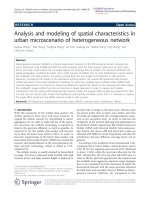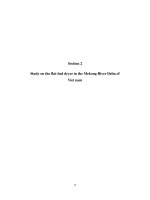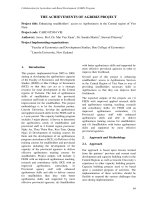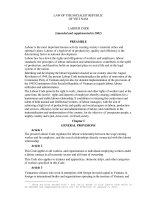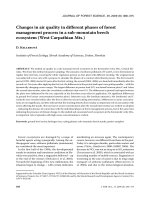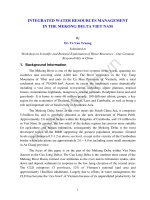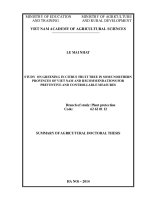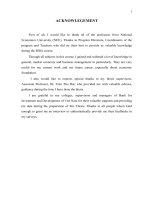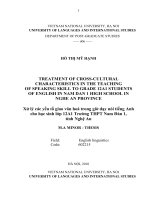Observed precipitation characteristics in MJO phases of Viet Nam
Bạn đang xem bản rút gọn của tài liệu. Xem và tải ngay bản đầy đủ của tài liệu tại đây (853.55 KB, 13 trang )
Vietnam Journal of Hydrometeorology, ISSN 2525-2208, 2019 (02): 51-63
Research Paper
OBSERVED PRECIPITATION CHARACTERISTICS IN MJO PHASES
OF VIET NAM
Le Minh Duc1, Le Thi Hong Van2, Hoang Phuc Lam2
ARTICLE HISTORY
Received: March 12, 2019 Accepted: June 08, 2019
Publish on: June 25, 2019
ABSTRACT
The research uses synoptic station data and
MJO index to analyse the precipitation distribution all over Viet Nam. The mean rainfall amount
in the Northern region tends to increase in MJO
phases 1 and 2; the rainfall anomalies in the
North Central provinces are positive in phases
3, 4 and 5; from Middle Central to Southern
provinces, MJO increases the rainfall, especially
in phases 4 and 5. During transitional seasons
(MAM and SON), positive rainfall anomalies in
those wet phases tend to be higher than those in
summer and winter, especially in SON.
Keywords: Rainfall anomaly, MJO, wet
phases.
1. Introduction
The MJO is a tropical large-scale oscillation
that is dominated by periods of 30-60 days and
the zonal wave number one propagating eastward (Madden and Julian, 1971). It is the low
frequency variation in the intensity of the wind
in the upper atmosphere and the variation of temperature at different levels combined with the
surface pressure. The longest oscillation period
is at about 41-53 days and has the largest frequency at about 45 days. The 40-50 day fluctu-
ation is the basis for explaining some of the low
frequency fluctuations of tropical circulation and
climate fluctuations. Among these characteristics, the movement from west to east of the 4050 day oscillation has the greatest significance.
This movement is expressed as an atmospheric
wave, most of which is related to the movement
of intense convection. These convections move
at speeds of 10-30 m/s from the Indian Ocean to
the western Pacific Ocean and across the Pacific
Ocean to South America. The surface effects of
convection movement to the east can be seen in
some equatorial regions suitable for temperature
and surface pressure changes with a 40-50 day
cycle.
In addition to the above-mentioned spatial
characteristics, oscillations of 40-50 days also
have varying characteristics over noticeable
time. For example, the variation between seasons
is reflected in the nature of this oscillation. Subseasonal variation, including 10-20 days, 30-50
days and a week fluctuations (Ding, 1994) is the
most important because this oscillation has
major implications for the active and inactive
phases of the monsoon. The oscillation has its
own intensity variation with the weakest in the
Western Pacific and the strongest in the Indian
Ocean. The figure below gives an example of
phase space diagram (Wheeler and Hendron,
HOANG PHUC LAM
Corresponding author:
1
Ha Noi University of Natural Resources and Environment
2
National Center for Hydro-Meteorological Forecasting
51
Le Minh Duc et al./Vietnam Journal of Hydrometeorology, 2019 (02): 51-63
2004) of MJO representing position (areas from
1 to 8) and intensity (distance to the center of
simplicity map) of MJO. Based on the two char-
acteristics RMM1 and RMM2 in phase space,
we will determine the current MJO location and
intensity.
Fig. 1. Schematic representation of phase space of MJO with values of two characteristics RMM1
(horizontal axis) and RMM2 (vertical axis), global ocean areas (represented by numbers from 1 to
8) in which the Western Pacific region are two regions 6 and 7. Colors represent the months (redMay, Green - June and Blue - July).
Donald et al. (2006) evaluated the effect of
the MJO on global-scale rainfall and found that
MJO is an important phenomenon that may affect the daily rainfall distribution, even in high
latitudes, through teleconection to large-scale sea
level atmospheric pressure. Donald et al. (2006)
also emphasized that MJO could be the mechanism and a predictor to bridge the weather forecast (usually only within the 5-day limit) and
climate forecast (often highly skilled in 3-6
month forecasts). Through the composite of
anomalies in the summer of the Northern Hemisphere in different MJO phases (2, 4, 6, and 8),
52
there is a close relationship between the positive
anomalies of precipitation and negative anomalies of mean sea level pressure and vice versa.
The MJO has a direct impact on the weather
in the tropical region, as it organizes convection
and precipitation. There have been many studies
on the impact of the MJO on the South and East
Asian (EA) region. Most of them, however, are
for the boreal summer season (Zhu et al., 2003a,
2003b; Zhan et al., 2006). In summer, the MJO
related intraseasonal disturbances tend to propagate northeastward that significantly influence
the “active” and “break” monsoon rainfall fluc-
Observed precipitation characteristics in MJO phases of Viet Nam
tuations (Yasunari, 1979; Murakami et al., 1984;
Wang et al., 2006). The disturbances associated
with the MJO directly modulate the rainfall over
the Asian continent through its influence on the
genesis of higher frequency monsoon lows and
depressions. As revealed by Goswami et al.
(2003), a majority of such monsoon lows and depressions develop during the wet phase of the
MJO. A recent study of Zhang et al. (2009) reported a significant impact of the MJO on summer rainfall in southeast China. The impact of
the MJO on wintertime weather in East Asia, especially in its midlatitude region, is less well
documented.
2. Data and method
The present study is based primarily on two
data sources: observation rainfall data from 59
synoptic stations along Viet Nam that was provided by the National Centre for Hydro-Meteorological Forecasting, Viet Nam.
To identify phases of the MJO, we use the
real-time multivariate MJO (RMM) index of
Wheeler and Hendon (2004), which was downloaded from the Australian Bureau of Meteorology and is currently available from
All data
collected from 1997 to 2015.
To analyse the characteristic of Viet Nam’s
precipitation in MJO phases, we extract days
which is the same MJO phases to calculate
anomaly of precipitation for 59 synoptic stations.
For instance, rainfall anomaly of MJO phase 1
in January will be calculated by rainfall average
of phase 1 minus rainfall average in January.
Other phase anomalies are calculated similarly
as above.
3. Characteristic of precipitation in Viet
Nam in MJO phases
3.1. Characteristic of precipitation in MJO
phase
Before examining the details of rainfall distribution in each MJO phase in each month, we
analyzed the average rainfall characteristics in
each phase in climate regions. Daily rainfall of
59 synoptic stations will be averaged for each
phase in the period from 1997-2015. In which,
it is divided into 3 main areas: Northern region;
Central region and Central Highlands - Southern
regions.
Fig. 2 shows the average rainfall in each
phase in the Northern region. The graph shows
that the daily mean rainfall in the Northern region is slightly different between phases, about
3-5mm/day, except for those stations have higher
daily mean rainfall in most phases such as Lai
Chau, Hoa Binh (Tay Bac), Sa Pa, Ha Giang
(Viet Bac), Thai Nguyen, Tien Yen (Dong Bac).
It can be recognized that, the daily mean rainfall in phase 1 and phase 2 tends to be higher
than other phases; additionally, in the delta region, the rainfall in phase 4 is also higher. The
MJO is likely to increase rainfall in the Northern provinces in phase 1, phase 2 and in the delta
region in phase 4.
In the Central region (Fig. 3), the difference
in daily mean rainfall between phases is higher.
The North Central provinces have the highest
daily mean rainfall in phase 3, phase 4, phase 5
of which phase 4 is highest; Central and South
Central provinces are phase 4, phase 5 (phase 5
is highest). There are also a number of stations
that recorded remarkable rainfall in most phases
such as Ky Anh, Hue, Quang Ngai, Quy Nhon
and Truong Sa.
The Central Highlands-Southern region is the
most southern region of Vietnam, the daily mean
rainfall in this region is strongly modulated by
the MJO, especially in the phase 5 and phase 4,
especially at stations like Phu Quoc, Ca Mau and
Pleiku (Fig. 3).
53
Le Minh Duc et al./Vietnam Journal of Hydrometeorology, 2019 (02): 51-63
Fig. 2. The mean rainfall in each phase of the Northern region (Y axis is the daily mean rainfall; X
axis is the MJO phases).
Fig. 3. The mean rainfall in each phase of the Central region (Y axis is the daily mean rainfall; X
axis is the MJO phases).
54
Fig. 4. The mean rainfall in each phase of the Central Highland- Southern region (Y axis is the daily
mean rainfall; X axis is the MJO phases).).
Observed precipitation characteristics in MJO phases of Viet Nam
By analyzing the daily mean rainfall distribution characteristics in each MJO phase, the
higher daily mean rainfall is concentrated in
phases 1 and 2 in the Northern region, phase 3,
4 and 5 in the Central region and Central Highlands - Southern provinces. However, the difference in rainfall between highest and lowest
phases is not much.
In the next section, we will investigate the
characteristics of rainfall distribution in each
month by calculating the phased rainfall anomaly (i.e average rainfall minus monthly average
rainfall in the period from 1997-2015). From the
above characteristics, in the analysis of rainfall
characteristics in each month, we will mostly
focus on considering phase-averaged rainfall
anomaly in phases 1, 2, 3, 4, 5 and some phases
which have mean rainfall is higher than monthly
mean rainfall.
3.2. Characteristic of precipitation in summers
In summer season (JJA), large-scale systems
that have major impacts on Vietnam's weather
are subtropical high pressure, Intertropical Convergence Zone (ITCZ), hot and dry low-pressure-area, tropical cyclones in the north and the
southwest monsoon in the southern provinces. In
this study, we analyzed the relationship between
the MJO and the distribution of rainfall in Vietnam through rain characteristics in the MJO
phases.
The observed rainfall anomalies in June and
August in most of the stations are negative the
phase 1 of the MJO, whereas in July, the observed anomaly are positive in the Northern
provinces and negative elsewhere.
In phase 2, rainfall anomalies tend to be positive in the coastal stations of the Northern region in June and August. In July, rainfall
anomaly is slightly positive in the north of Central provinces Vietnam. The southern provinces
still maintain lower rainfall than the corresponding monthly mean rainfall (Fig. 5).
Fig. 5. The rainfall anomaly of phase 2 in Viet Nam in summer months (JJA), including: (a) June,
(b) July and (c) August.
In June and August, positive rainfall anomalies in phase 3 are higher and expand further
south (Fig. 6). In June, positive rain anomaly
area is concentrated in the mountainous and
highland areas of the North and Center of the
Central provinces (from Quang Tri to around
Quang Ngai). By August, rainfall anomaly has
increased, especially in the northeast provinces
of Northern Vietnam, then extended to the MidCentral provinces. Rainfall anomaly in phase 3 is
almost the same as phase 2 in July.
55
Le Minh Duc et al./Vietnam Journal of Hydrometeorology, 2019 (02): 51-63
Fig. 6. The rainfall anomaly of phase 3 in Viet Nam in JJA months, including: (a) June, (b) July and
(c) August.
Fig. 7. The rainfall anomaly of phase 4 in Viet Nam in JJA months, including: (a) June, (b) July and
(c) August.
The rainfall anomalies in phase 4 of June and
July are clearly above normal for most of the stations in Vietnam, especially for the southern stations. However, in August, the rainfall anomaly
Northern provinces shifted to negative, whereas
the positive observed rainfall anomalies remained in the north central and southern
provinces (Fig. 7).
The rainfall anomaly in phase 5 (Fig. 8) has
56
increased rapidly in August, especially in the
Mid-Central provinces. Meanwhile, in June and
July, the rainfall anomaly in this phase decreased
gradually in the Northern provinces, of which
many stations turned to negative anomaly compared to phase 4. The positive rainfall anomaly
in the southern provinces also tends to decrease
slightly but still be positive.
Observed precipitation characteristics in MJO phases of Viet Nam
Fig. 8. The rainfall anomaly of phase 5 in Viet Nam in JJA months, including: (a) June, (b) July and
(c) August.
Fig. 9. The rainfall anomaly of phase 6 in Viet Nam in JJA months, including: (a) June, (b) July and
(c) August.
In phase 6 (Fig. 9), the mean rainfall decreased rapidly in JJA months, in which August
had the most decrease compared to previous
phase 4 and 5. This decrease trend of the rainfall
anomaly continues in phase 7 and 8 resulting the
wide-spread negative rainfall anomaly in phase 7
all over Vietnam. The exception was observed in
phase 8 rainfall anomaly in August with the dipole pattern of positive rainfall anomaly in the
north and negative anomaly in the south.
The analysis of rain distribution in each MJO
phase in the JJA shows that: in phase 4 and phase
5, the rainfall anomaly tends to be higher than
monthly mean rainfall mostly all over Vietnam,
with maximum positive anomaly in the MidCentral, South-Central, Highlands and Southern
provinces. In addition, in phase 3 and phase 6,
in the Northern provinces, the near or above normal mean rainfall are also observed. Phase 1 and
phase 7 in summer months are dry phase and
57
Le Minh Duc et al./Vietnam Journal of Hydrometeorology, 2019 (02): 51-63
phase 8 shows a dipole pattern of rainfall anomaly along Vietnam.
3.3. Characteristic of precipitation in Winters
In DJF months, the large-scale systems controlling Vietnamese weather are mainly cold
surge, upper westerly jet stream in the north or
equatorial trough and subtropical high in the
south. Therefore, the activity of MJO could be
one of the factors directly or indirectly associated with these large-scale systems and affecting
the weather including the rainfall distribution in
Vietnam during this time.
Fig. 10. The rainfall anomaly of phase 4 in Viet Nam in DJF months, including: (a) December, (b)
January and (c) February.
Fig. 11. The rainfall anomaly of phase 5 in Viet Nam in DJF months, including: (a) December, (b)
January and (c) February
58
Observed precipitation characteristics in MJO phases of Viet Nam
The rainfall anomalies in phase 4 are positive
in December and February whereas the phase 4
rainfall anomaly in January is negative countrywide (Fig. 10).
During DJF, the positive rainfall anomaly in
phase 5 is less than in JJA. The mean rainfall is
only slight higher than normal in some coastal
stations in the south-Central and Highlands in
December and January. In February, most rainfall anomalies have negative values (Fig. 11).
Thus, in DJF months, the positive rainfall
anomalies are often observed in phase 4, especially in December and February. In other
phases, the rainfall anomalies are negative.
3.4. Characteristic of precipitation in transition period
During transition months, the dominate largescale weather systems in Vietnam tend to
weaken or dispute each other so the weather
forecast in general and rainfall in particular is extremely difficult, especially in medium, extended
range forecasts and beyond. Considering the
characteristics of rain distribution in MJO phases
of transition months is also one of the important
factors to help forecasters have more reference
tools before making a final official forecast.
Fig. 12. The rainfall anomaly of April in Viet Nam in DJF months, including: (a) Phase 4, (b) Phase
5 and (c) Phase 6
In April (Fig. 12), the observed rain anomalies in the phases 4, 5 and 6 shows positive values in the Southern region. Therefore, it can be
seen that the activity of MJO during this period
also partly affects the rainfall distribution in the
Southern provinces where as negative elsewhere
in Vietnam.
Phase 7 of the MJO in April and May cause
the mean rainfall anomaly (Figs. 13a-13b) to be
positive most of Vietnam, except for some sta-
tions in the west of the Southern region in April
and in the North of Vietnam in May.
Considering the transition period from summer to winter, including September, October and
November. Fig. 14 shows that the positive rainfall anomalies appear more frequently during
this period. The mean rainfall in phase 4, phase
5, phase 6 tend to be higher than corresponding
monthly mean rainfall. In phase 4 (Fig. 14), positive rain anomalies focus mainly on the
59
Le Minh Duc et al./Vietnam Journal of Hydrometeorology, 2019 (02): 51-63
provinces from the south of the Northern Delta
to the Highlands -Southern in September, October. In November, the positive rainfall anomalies
continued to cover all Northern provinces; In addition, the rainfall anomaly values also tends to
be higher in the Central coast region. This shows
that MJO is likely in increasing rainfall anomaly
in phase 4 in Vietnam in general and in the Middle Central provinces in particular.
Fig. 13. The rainfall anomaly of phase 7 in Viet Nam in DJF months, including: (a) April, (b) May.
Fig. 14. The rainfall anomaly of phase 4 in Viet Nam in transition months, including: (a) September, (b) October and (c) November.
60
Observed precipitation characteristics in MJO phases of Viet Nam
In phase 5 (Fig. 15), the positive rainfall
anomalies are gradually narrowed to the south,
concentrate on Central and Highland-Southern
provinces. Specially, in November, it is still the
highest positive rainfall anomaly in the Central
coastal provinces.
Fig. 15. The rainfall anomaly of phase 5 in Viet Nam in transition months, including: (a) September, (b) October and (c) November.
Fig. 16. The rainfall anomaly of phase 6 in Viet Nam in transition months, including: (a) September, (b) October and (c) November.
61
Le Minh Duc et al./Vietnam Journal of Hydrometeorology, 2019 (02): 51-63
In phase 6 (Fig. 16), the mean rainfall anomalies tend to decrease in October and November.
But in September, the rainfall anomalies show
the highest positive values, especially in the
Northern and North Central provinces.
Thus, in transition months, the mean rainfall
in each phase tends to be higher than corresponding monthly mean rainfall. It is also higher than
DJF or JJA months. The higher rainfall anomalies are often concentrated in phases 4, 5 and
then phase 6. In other phases, the rainfall anomalies are more mostly negative.
4. Conclusion
In the Northern provinces, the mean rainfall
anomalies in phases 1 and 2 of MJO are higher
than in other phases. In the North Central regions, the higher rainfall are in phases 3, 4 and 5.
From Middle Central to the Southern provinces,
phases 4 and 5 are considered as the wettest
phases. However, there are not much differences
between phases which have the highest and lowest positive rainfall anomalies.
Although MJO is a tropical oscillation, its influence on rainfall distribution in Vietnam is not
only in the Southern provinces but also in the
Northern provinces. Phase 4 and phase 5 are two
phases where the MJO increases rainfall anomalies in Vietnam; the next wet phases are 3, 6 and
7. During transitional seasons, positive rainfall
anomalies tend to be higher than summer and
winter, especially in September, October and
November.
References
1. Ding, Y.H., 1994. Monsoons over China,
Kluwer Academic Publishers, Dordrecht/
Boston/ London, pp. 419.
62
2. Donald, A., Meinke, H., Power, B., Maia,
A.H.N., Wheeler, M.C., White, N., Stone, R.C.,
Ribbe, J., 2006. Near-global impact of the Madden-Julian Oscillation on rainfall. Geophysical
Research
Letters,
33
(9):
L09704,
doi:10.1029/2005GL025155.
3. Goswami, B.N., Ajayamohan, R.S.,
Xavier, P.K., Sengupta, D., 2003. Clustering of
low pressure systems during the Indian summer
monsoon by intraseasonal oscillations. Geophysical Research Letters, 30 (8): 1431.
doi:10.1029/ 2002GL016734.
4. Madden, R.A., Julian, P.R., 1971. Detection of a 40-50 day oscillation in the zonal wind
in the tropical Pacific. J. Atmos. Sci., 28: 702708.
5. Murakami, T., Nakazawa, T., He, J., 1984.
On the 40-50 day oscillations during the 1979
Northern Hemisphere summer. Part I: Phase
propagation. J. Meteorol. Soc. Jpn., 62: 440-467.
6. Wang, B., Webster, P., Kikuchi, K., Yasunari, T., Qi, Y., 2006. Boreal summer quasimonthly oscillation in the global tropics. Clim.
Dyn., 27: 661-675.
7. Wheeler, M.C., Hendon, H.H., 2004. An
All-Season Real-Time Multivariate MJO Index:
Development of an Index for Monitoring and
Prediction. Monthly Weather Review, 132 (8):
1917-1932.
8. Yasunari, T., 1979. Cloudiness fluctuations
associated with the Northern Hemisphere summer monsoon. J. Meteorol. Soc. Jpn. 57: 227242.
9. Zhan, R., Li, J., Gettelman, A., 2006. Intraseasonal variations of upper tropospheric
water vapor in Asian monsoon region, Atmos.
Chem. Phys. Discuss. 6: 8069-8095.
doi:10.5194/acpd-6-8069-2006.
10. Zhang, L., Wang, B., Zeng, Q., 2009. Impact of the Madden-Julian Oscillation on sum-
Observed precipitation characteristics in MJO phases of Viet Nam
mer rainfall in southeast China. J. Clim. 22: 201216.
11. Zhu, C., Tetsuo, N., Li, J., 2003a. Modulation of twin tropical cyclogenesis by the MJO
westerly wind burst during the onset period of
1997/98 ENSO, Adv. Atmos. Sci. 20 (6): 882898.
12. Zhu, C., Tetsuo, N., Li, J., Chen, L.,
2003b. The 30-60 day intraseasonal oscillation
over the western North Pacific Ocean and its impacts on summer flooding in China during 1998,
Geophys. Res. Lett. 30 (18): 1952.
doi:10.1029/2003GL017817.
63
